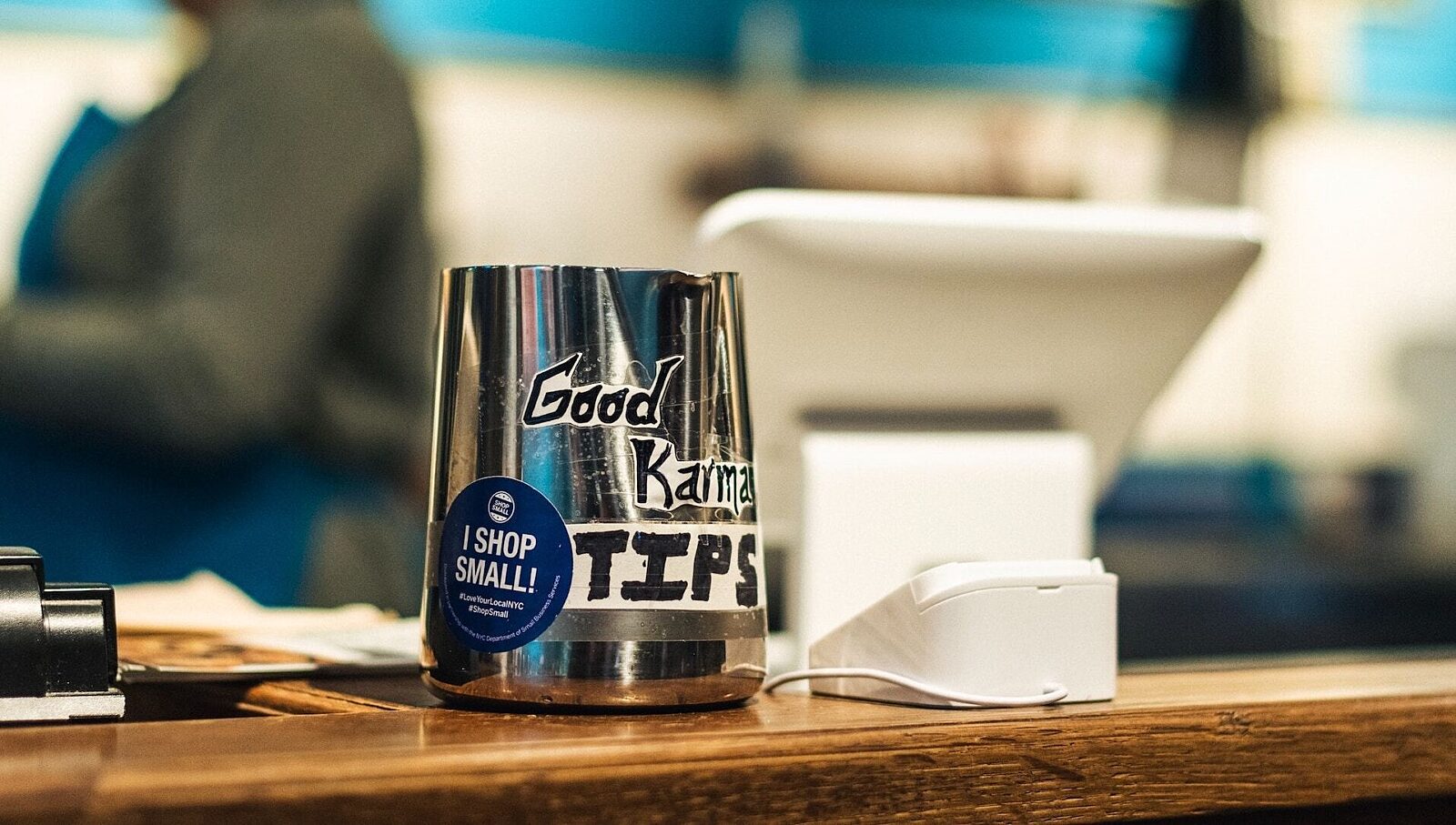
Restaurant Tipping Guide: How to Adequately Tip at a Restaurant in 2024
We should all know what to tip at a restaurant. This guide will help guests determine how much to tip and help restaurants navigate gratuity in 2023.

Tessa ZuluagaAuthor


Restaurant Operator Insights Report
See insights from real restaurant operators which can help you benchmark your current and planned restaurant technology stack against your peers as we head into 2024 and beyond.
What is the proper amount to tip at a restaurant?
In a full-service restaurant, it’s customary to tip at least 20% of your tab.
Dining out at new restaurants is a joyful experience. However, knowing how to tip at a restaurant properly is essential. Tipping etiquette can be tricky, with different countries and cultures having their own norms and expectations. And even within a country, tipping can vary based on the type of establishment or the level of service provided. Full-service restaurant tips averaged 19.6% in Q4 2022, dropping from 19.8% in Q4 2021. That’s some disappointing news for industry workers who depend on tips to make a living.
In this restaurant tipping guide, we'll explore the current tipping landscape in 2023 and provide practical tips to help you navigate the world of restaurant tipping with ease. Whether you're a seasoned diner or a first-time visitor to a restaurant, this guide will help ensure you leave a fair and adequate tip for your server.
Employee Handbook Template
Outline your restaurant’s staff policies in this customizable Word doc to help restaurant management and staff get on the same page.

An Overview of Restaurant Tipping
Tipping, also known as gratuity, is a voluntary payment made to someone who provides a service, in addition to the cost of the service itself.
Tipping is a common practice in many countries and is usually given as a percentage of the total bill. The primary reason tipping exists is to provide an incentive for the service provider to give better service. In the service industry, a tipped-wage worker is an employee who receives a lower minimum wage than a non-tipped worker, with the expectation that they’ll earn additional income through tips. This is a win-win scenario for business owners: lower labor costs and (hopefully) stronger customer service.
There are arguments both for and against tipping, centered around the Fair Labor Standard Act. This act states that an employer of a tipped employee is only required to pay $2.13 per hour in direct wages if that amount combined with the tips received at least equals the federal minimum wage. It also states that if the employee's tips combined with the employer's direct wages of at least $2.13 per hour do not equal the federal minimum hourly wage, the employer must make up the difference.
Let’s start with the pro-tipping arguments. The waitstaff at full-service restaurants earn a median of $27 an hour, with the highest-paid tipped employees making $41.50 an hour. A National Restaurant Association survey in 2022 found that 75% of customers prefer this traditional tipping system. If restaurants switched to a higher hourly wage, many would have to cut costs. This may include cutting operating hours and increasing menu prices.
On the other hand, anti-tippers argue that it puts too much pressure on customers to determine the worker's income. Some sources also claim the Fair Labor Standard Act is not being upheld. For example, 83.8% of full-service restaurants improperly calculated wages for tipped workers from 2010-2012. Essentially, those against tipping suggest restaurants give employees a higher hourly rate to ensure a livable wage.
Tipflation
Since the pandemic, there has also been an increase in “tipflation”. According to Cornell University consumer behavior professor Michael Lynn, other types of employees are starting to ask for tips – while still making a higher hourly rate. For example, at a coffee shop, you might notice a tip option pop-up on the screen when you go to pay. There’s nothing necessarily wrong with this – but it’s not required, and a dollar or two will suffice if you choose to tip.
However, in a full-service restaurant, it’s important to tip at least 20% of your tab. If you think that’s a high number, you might not know that servers rarely get to keep all of those tips. Instead, they actually tip out the bar staff, food runners, and bussers. This tip out is commonly a percentage of food and beverage sales, regardless of what the guest tips. In other words – if they are stiffed on a tip they are probably losing money.
Restaurant Tipping Guide & Chart
If the check gets dropped off at your table and you’re not sure what to tip, try a restaurant tip calculator. A tool like this does the math and adds the total for you. This way, you can ensure you write the correct numbers on the receipt, regardless of how many craft cocktails you may (or may not) have consumed at dinner.
Restaurant Tipping Chart
Use this tipping chart to help decided what to tip based on the service type.
Service type | Tip amount |
Bar | $1-$2 per drink ordered |
Full-Service Restaurant | 20% of your total bill |
Quick-Service Restaurant | 10% (optional) |
Coffee Shop or Cafe | $1-$2 (optional) |
Online Ordering or Takeout | $1-$5 (optional) |
Delivery | 20% of your total bill |
Additional Restaurant Tipping Best-Practices
Depending on the restaurant’s point of sale system, suggested tips may show as either percentages or hard amounts. It is up to the restaurant to choose which option is best for their business. Guests can either select one of the suggestions or add an amount of their choosing. Here are some other best practices to consider when tipping:
Tipping pre-tax vs. post-tax – Tipping pre-tax vs. post-tax can be a source of confusion for many diners. The general rule of thumb is to calculate the tip based on the pre-tax total, rather than on the full amount including tax.
This is because the tax is a mandatory charge collected by the government and does not go directly to the server or restaurant staff. Tipping on the pre-tax total ensures that the server is being fairly compensated for their work, without including the tax amount in the calculation. However, if a guest wants to tip after tax, that’s a great way to give extra thanks to your sever – it’s just not required!
Tipping on full tab pre-split checks – It's important to note that dividing the tip based on individual portions of the check can be more complicated and time-consuming, especially for larger groups. It may also be difficult to split the check evenly if some diners paid with cash while others used credit cards or other forms of payment.
In general, it's recommended to base the tip on the full tab rather than on individual portions. This ensures that the server is fairly compensated for their work, and can help to avoid confusion or disagreements among the diners.
Tip for large parties (traditionally 6 or more) – This is another topic some guests might miss. In fact, this happens so often that many restaurants have implemented automatic gratuities, usually between 18-20%. The reason for this policy is that serving a large party can be significantly more challenging and time-consuming than serving a smaller table. It requires more attention from the server, as well as potentially more coordination with the kitchen and other staff members. By adding an automatic gratuity or service charge, the restaurant ensures that the server receives a fair tip for their hard work.
Tipping on a credit card vs. cash – There are two main ways to leave a tip: on a credit card or with cash. While both methods accomplish the same goal of rewarding good service, there are some key differences worth considering. One difference is how quickly the tip gets to the server. When a tip is left on a credit card, it can sometimes take several days for the server to receive it, as some restaurants must process the payment and then distribute the tips. Cash tips are immediately available to the server, which can be a big help in managing finances.
Both methods of tipping have their pros and cons. Just remember that regardless of how the tip is left, it's always appreciated by the hardworking servers who rely on them to make a living.
Tipping Best Practices for Restaurant Management
1. Staff wages will vary – When managers assign front-of-house sections, they have an immense amount of power and responsibility. At any given restaurant, one section can make double what another does. This is due to table sizes, location in the restaurant, and guest preferences. As a manager, it’s important to rotate what sections your servers are assigned to each week. This way, each member of your staff has the opportunity to work a combination of the most and least prosperous sections.
Another way to combat the unevenness of your sever sections is by tip pooling. Tip pooling is when a portion or all of the tip money from the night is collected and redistributed evenly or by a set percentage — instead of each individual server keeping the tips they earned individually. Staff satisfaction is a huge deciding factor when considering moving to a tip-pooling model. So if you’re looking to pivot to or away from a tip pooling model, the first thing you’ll want to do is survey your current staff for their preference.
2. Tips go to the staff, not the restaurant – The tips are for the workers – not the business. There are laws in place to protect tipped-wage workers, who are typically paid a lower hourly wage than non-tipped workers. In the United States, the federal minimum wage for tipped workers is currently $2.13 per hour, as compared to the standard minimum wage of $7.25 per hour for non-tipped workers. However, if a tipped worker's total hourly earnings (including tips) do not add up to the standard minimum wage, the employer is required to make up the difference.
3. Staff must be trained in how to declare tips – In the United States, tipped workers are required to report all tips received into their payroll or POS system so that they can be reported to the Internal Revenue Service (IRS).
To ensure compliance with tax laws and regulations, restaurants should provide training to their staff on how to accurately track and report their tips. This may include providing guidance on how to record tips in the POS system, as well as how to report tips to the employer at the end of each shift or pay period.
Moreover, during tax season tipped workers must report all of their tips on their tax returns. Employers are required to report all tips to the Internal Revenue Service on Form 8027, which is used to calculate the employer's portion of the Social Security and Medicare taxes on tip income. The employer must also provide each employee with a W-2 Form at the end of the year that reflects the total amount of tips received during the year.
Tipped workers must then report their total tips received on their individual tax returns using Form 1040. This information is used to calculate the worker's taxable income and determine how much tax they owe to the federal government. Failure to properly report all tip income can result in penalties and fines from the IRS, as well as potential legal and financial consequences for the worker and the employer. This is an important process, and shouldn’t be overlooked.
4. Shifting guest sentiment around “suggested tips” – It has become increasingly common for restaurants to include suggested tip amounts on their receipts or in their payment systems. These suggested tips are often presented as a percentage of the total bill, with options ranging from 15% to 20% or higher. The use of suggested tips can be seen as a way for restaurants to help their customers navigate the often-confusing world of tipping, while also ensuring that their staff receives fair compensation for their work.
However, the use of suggested tips has also generated some controversy and criticism, particularly in light of the current economic climate. With many people experiencing financial hardships, some customers may feel that they are unable to afford the suggested tip amounts, or that they should not be expected to pay more for service in the current economic climate.
It’s ultimately up to the restaurant if they want to add “suggested tips” for their workers to gain. Let it just be known that this suggestion may turn off certain guests from your business.
5. The need for transparency with guests about tips – By clearly communicating where the tips are going, why tipping is allowed, and whether or not it's encouraged, restaurants can help customers make informed decisions about how they want to show their appreciation for excellent service. These types of communication can be made on social media and on your website, in your restaurant, and/or printed on the bottom of your menu.
- Where the tips are going – In 2023, customers are likely to be more interested in knowing where their tips are going. Some restaurants may choose to use a revenue-sharing model, in which tips are distributed equally among all staff members, while others may choose to allow servers to keep their own tips. Regardless of the model, it's important for restaurants to clearly communicate their tipping policies to customers so that they know how their tips will be used.
- Why you allow for tipping – Tipping has been a part of restaurant culture for a long time, but some customers may wonder why it's necessary. Restaurants may want to explain to customers that tipping allows them to pay their employees a fair wage while keeping menu prices reasonable. By allowing customers to tip, restaurants can also provide an incentive for servers to provide excellent service, which can lead to higher customer satisfaction and increased business.
- Tips are/aren’t encouraged – As discussed earlier, some restaurants may choose to adopt a no-tipping policy, in which service charges are included in the menu prices. However, others may still allow for tipping. Regardless of the policy, it's important for restaurants to clearly communicate whether or not tipping is encouraged. If tips are not encouraged, customers may wonder whether or not they should tip and how the money will be used. On the other hand, if tips are encouraged, restaurants may want to explain why they believe tipping is important and how it benefits their employees.
Tipping at restaurants is an important part of our dining culture, and it's essential to know how to do it properly. By following the tips provided in this restaurant tipping guide, you can ensure that you leave an adequate tip for your server, show appreciation for their hard work, and contribute to a positive dining experience for everyone involved. Remember that tipping is not a gesture of kindness. It is a way to support the service industry and the people who work hard to make our dining experiences memorable.
So, next time you visit a restaurant, keep these tips in mind and leave a fair and adequate tip for your server. Happy dining!
Is this article helpful?
DISCLAIMER: This information is provided for general informational purposes only, and publication does not constitute an endorsement. Toast does not warrant the accuracy or completeness of any information, text, graphics, links, or other items contained within this content. Toast does not guarantee you will achieve any specific results if you follow any advice herein. It may be advisable for you to consult with a professional such as a lawyer, accountant, or business advisor for advice specific to your situation.
Read More
Subscribe to On the Line
Sign up to get industry intel, advice, tools, and honest takes from real people tackling their restaurants’ greatest challenges.



